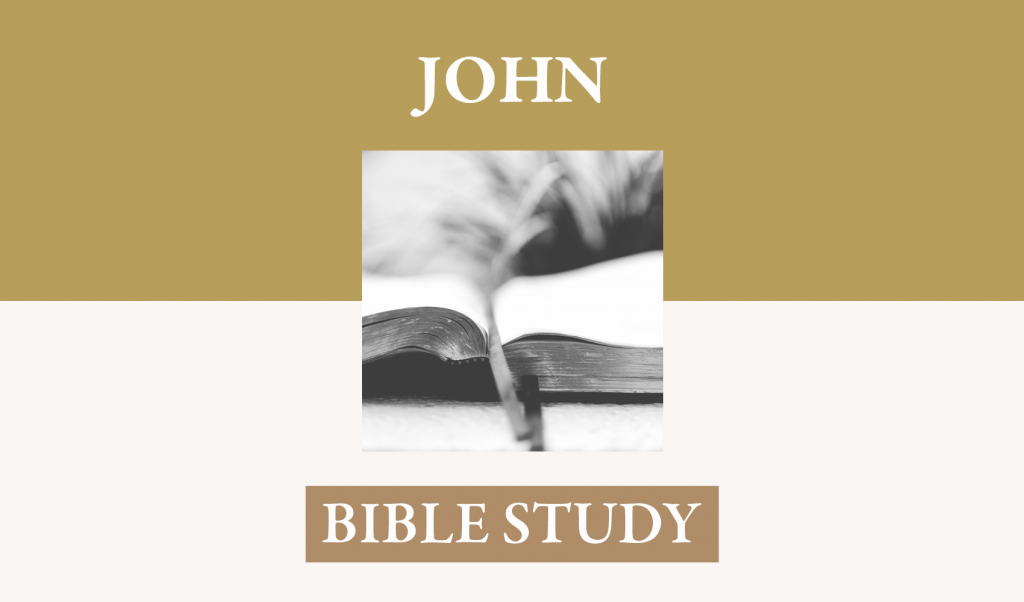John’s narrative begins in the opening verses with a theological presentation of Jesus as essentially God, by person the Son of God and in function the creator, sustainer, and redeemer. He also asserts the reality of his full manhood in the incarnation and the evidence for the undeniable truth of this mystery—Eternal God and temporal manhood in one person. He then continues with the beginning of the historical evidence for these claims. Jesus’ own words and actions and the confessions of those that experienced his presence and his teaching begin John’s furious pace of piling up the events that should lead one to confess that Jesus is the Messiah, the Son of God.
I.John Identifies Himself — Verses 19–28
A. Who He is not – John gives a direct response to a question from the religious leaders. His unconventional dress, his place of ministry and his call to repentance from the least to the greatest, from the most profane to those that served in the temple would certainly bring inquisitiveness about who he was. His call and practice clearly challenged the self-conceived authority of the Pharisees and their sense of moral superiority.
1. Messiah — John knew that they were wanting either some convincing manifestation of his right to be making religious requirements of the people or were wanting some reason to accuse him of blasphemy. So, immediately he disarms the accusation of blasphemy by stating clearly that he is not the Messiah. This disclaimer stands in stark contrast to Jesus’ claim in Matthew 16:16, 17 and John 4:26.
2. Elijah — Malachi 4:5, cf. Mt. 11:7-19 (14); 16:13, 14. From these texts it seems that people were expecting a reappearance of Elijah. John, therefore, says he is not Elijah, for he was not in the sense in which they were asking it. So he identifies himself as below.
3. The Prophet — Deuteronomy 18:15 – This is another of the messianic prophecies that John disclaims. Essentially John already has identified Jesus as this prophet in verse 18 by saying “He has made him known.”
B. Who He is. While he denies that he is the Messiah and he sidesteps misperceptions that his interrogators may have, he is clear as to what he has been assigned to do by God’s design and call.
1. Voice of one crying in the wilderness, “Make straight the way of the Lord.” He claims no identity other than as a mouthpiece.
2. Baptizer with water (verse 26) – See vs. 31, “So that he might be manifest to Israel;” He seems to indicate that he is introducing the newness of identification as to what it means to be a child of God; Compare with Matt. 3:7-12; a baptism of repentance, a gathering in of true wheat. This leaves no permanent physical mark of identification, but symbolizes a cleansing of heart, taken on voluntarily, not imposed physically apart from the involvement of the will of the recipient. The cleansing he symbolizes in water, Jesus actual bestows in the giving of His Spirit as a result of his reconciling work.
II. John Identifies Jesus — Verses 29–34 (See also Mt. 3:13-17) This represents a summary of John’s statements concerning Jesus around the time of his baptism
A. He is the Lamb of God who Takes away the sin of the world; also v. 36 [called Lamb 27 times in revelation]
1. He is identified as an unblemished, unprotesting sacrifice; the Passover sacrifice was a lamb. Peter, in writing of the ransom given for us says that it was done not with perishable things as silver and gold, “but with the precious blood of Christ, like that of a lamb without blemish or spot.” Those things that were required of the Passover lamb in type were fulfilled completely and immutabiy through the anti-type, the unblemished, holy, sinless Savior.
2. He sets forth his mission as distinctly concerning sin; the lamb is symbolic of all the sacrifices and indeed serves for all of them: cf. the sacrifices made for the healed leper in Leviticus 14; the sin offering, the guilt offering and the burnt offering.
3. Benefits expand beyond the nation of Israel – He takes away not only the sin of the remnant of his people among Israel but the sins of the world—that is, Christ’s Messiahship will gather to him all peoples from every tongue and notion.
B. Jesus is greater than John because of His pre-existence (30) and its implications — also see 27; John knows clearly that the one for whom he is forerunner is eternal and of infinite worth.
1. He consistently refers to the fact that Jesus, though coming after him was before him. John, the Evangelist, cites this testimony from John the baptizer as evidence for his theological argument that “the Word was God, … in him was life, … [and] he was the true light” and in seeing his glory one saw the unique eternal manifestation of glory from the Father.
2. His worthiness is seen in such phrases as “ranks before me (15, 30) and “whose sandal I am not worthy to untie” (27) and “this is the Son of God” (34).
C. He is the One who possesses and dispenses gifts of the Spirit (32, 33) – This function shows his eternal relationship with the Spirit; by his work he will immerse the church in the Spirit; cf 1 John 3:22-27; notice also use of oil in Lev. 14 after the sacrifices of the Lamb which shows by type that the operation of the Holy Spirit in regeneration, adoption, and sanctification is inextricably connected with the sacrifice of Christ for our sins and guilt.
1. He pours forth the Spirit – Acts 2:33 > cf. Joel 2:28, 29; Ezekiel 36:24-27
-
-
- At Pentecost Jews were gathered from all nations.
- The Book of Acts records how the Gentiles also were made to partake of this same work of the Spirit
-
2. His sacrifice creates the reality of life in the Spirit – Romans 8:1-4
-
-
- Christ’s sacrifice enables the work of the Spirit
- The Spirit gives us union with Christ, resulting in imputation of righteousness and transformation into his image.
-
3. He creates the church by the Spirit – 1 Cor 12:3, 12, 13
-
-
- He creates the spiritual life which is the foundation for the character of the church.
- He gives gifts by which the church grows into a unity in the faith and the knowledge of the Son of God – “unity of the Spirit in the bond of peace . . . One body and One Spirit Ephesians 4:3, 4.
- The operations of the Spirit in calling, regeneration, sanctification, gifting of the saints, and permanent indwelling come because Christ removes the offense hindering the outpouring of divine favor. The giving of Christ by the Father, the giving of his life by Christ, are fundamental to the giving of the Spirit and the effecting of all that He brings. Presently we have the “firstfruits” of the Spirit (Romans 8:23) with the abundant harvest of his work yet remaining to be fulfilled in eternity. Even so, because God has given us his Son he will freely give us all the blessings that he procured (Romans 8:32) both here and hereafter – “If the Spirit of him who raised Jesus from the dead dwells in you, he who raised Christ Jesus from the dead will also give life to your mortal bodies through his Spirit who dwells in you” (Romans 8:11).
-
D. Son of God — This is fundamental to the other aspects of Jesus’s identity
1. Only as Son can he be an adequate propitiation 1 John 4:10; Hebrews 5:5-9. The death of a mere man could not effect a restoration of sinners.
-
-
- A mere man could not endure divine wrath and fully propitiate it even in eternity.
- A mere man does not, by his death, give an equivalence of glory in his suffering to the implied loss and rejection of glory by a creature’s disobedience to a divinely-given law.
-
2. As Son his pre-existence and surpassing excellence is established, because it is not bare existence that is excellent but his full expression of the essence of God – Hebrews 1:1-4.
3. As Son, he receives and reciprocates the full joy and blessing of the Spirit. This mutual reciprocation constitutes the unity of the godhead in eternity; as Messiah, God and man in one person, his person has the Spirit without measure.
III. Transfer of Attention from John to Jesus — Verses 35–51
A. Two of John’s disciples go to Jesus [with John’s encouragement – 35, 36] Note the titles they immediately attribute to him: Rabbi (38), Messiah (41). Again, John identified Jesus as “Lamb of God.”
1. Jesus turned purposefully to begin his engagement with them in conversation. He begins his relationship with a question. This he will do on strategic issues throughout his ministry (3:10; 5:6, 44, 47; 6:5, 6, 67; 7:19; 8:10, 46; 9:35; 10:35, 36; 11:26; 13:38). The questions provide a barb that enlivens the spirit to seek an answer. In some situations, they point out the ignorance and hypocrisy of the one or group questioned.
2. His attention toward these first disciples emboldened them to seek time with him. They stayed all day, considering him from the beginning as a teacher who understood the ways of God. If they believed John’s message that Jesus was the “Lamb of God,” that pregnant phrase had the entire sacrificial system in the background. They would learn that the blood of bulls, goats, lambs, doves could not take away sin. Only the impeccable and unblemished Son of God who died as the blameless, innocent, and fully obedient Son of Man could be the propitiation for our sins.
B. Andrew brings Simon, his brother, telling him, “We have found the Messiah.” Jesus identifies and re-identifies him.
1. He knew his name and his progeny and said that he would be called Cephas, which means Peter, both of which mean rock.
2. Paul regularly used the name “Cephas” to refer to Peter (Galatians 1:18, 2:9 and 11; 1 Corinthians 1:12, 15:5).
3. Jesus reaffirms this after Peter’s confession at Caesarea Philippi (Matthew 16:15-17). His status as “rock” on which the church was built was his confession, “You are the Christ, the Son of the Living God” (Matthew 16:16).
C. Jesus calls Philip.
1. Note the phrase, “He purposed to go into Galilee” (43). This was not just a travel plan, but a seeking out of one of the twelve. It is an example of the way in which the Good Shepherd will seek his sheep and lose none of them. They will recognize his voice in their effectual calling, even as these first disciples recognized internally that this was indeed the Messiah, Son of God, King of Israel.
2. When Philip spent time with Jesus, he immediately found Nathanael and identified Jesus as “One about whom Moses and the Prophets spoke” (45). The power of a sinless person, uncorrupted by the fall, both to attract and repel (2:18) seems quite remarkable in the immediate responses of these soon-to-be disciples of Jesus. They follow and go find brothers and friends.
D. Philip brings Nathanael.
1. When Jesus tells Nathanael that he saw him under the fig tree, Nathanael calls him “Rabbi” and confesses that Jesus is “Son of God, King of Israel.”
2. Why this conclusion? Jesus had seen him before Philip called him. Nathanael probably was praying in private under the fig tree for the redemption of Israel. How would Jesus have seen him there? Though his human nature—conceived by the Spirit, offspring of a creature, finite, in need of comprehensive growth– was united with the person of the Son of God (“the holy begotten thing shall be called the Son of God” Luke 1:35), he still maintained all the natural and intrinsic capacities and functions of his deity. His power, and thus knowledge, pervades and upholds all things. His knowledge of his elect and all that pertains to them is exhaustively concurrent.
3. The elect, though they did not know to ask in his name (John 16:24), always have approached the Father through the mediation of the Son. Jesus called Nathanael “an Israelite indeed in whom there is no deceit!” Jesus knew him as one of the elect, having been given a new heart by the Spirit (Ezekiel 36:26, 27). Nathanael concluded that Jesus, therefore, was the “One to be ruler of Israel, whose goings forth are from of old, from everlasting. … He pleads my case and executes justice for me” (Micah 5:2; 7:9).
4. The Father gave them to the Son in eternity (John 17:2); now, he has begun calling them in person, something he will continue to do through his Holy Spirit after his ascension (John 16:7-15).
E. It is for verification of the legitimacy of these conclusions drawn by these early disciples that John approaches his narrative the way he did.
1. Throughout this gospel John gives evidentiary miracles, extended discourses by Jesus, and the claims Jesus makes concerning his person and work: “I am the Way, the Truth, and the Life;” “I am the Good Shepherd; “I lay down my life for the sheep; “These [the Scriptures] are they who testify of me.”
2. At the end, John stated his purpose in this method of presentation: “These are written so that you may believe that Jesus is the Christ, the Son of God, and that by believing you may have life in his name” (20:31).
3. Throughout, John includes the responses to these various signs and sayings, responses of unbelief and cascading hatred on the one hand or responses of belief and accumulating love on the other (John 15:10, 18-19).
F. Jesus’ ministry was observed by angels (51).
1. Paul in 1 Timothy 3:16 puts the phrase “seen by angels” as a strategic element of the church’s confession of faith.
2. If Nathanael concluded that Jesus is Son of God and King of Israel merely from his perception that Jesus had first hand knowledge of his identity and character, how much more will the observable ministry of angels at critical moments in Jesus’ life confirm these deductions?
3. This probably confirms that Nathanael was praying for the redemption of Israel at a place of secret devotions, and Jesus in his continuing omnipresence as Son of God had received and interceded for him in these prayers. Nathanael knew the promise and saw it fulfilled: “They will call on my name, and I will answer them. I will say ‘This is my people’; and each one will say, ‘The Lord is my God.’”
4. Beyond that, during his work as Messiah, as Son of Man, angels attended Jesus in every stage.
-
-
- Annunciation (Luke 1:26-38)
- Temptation (Matthew 4:11)
- Garden (Luke 22:43)
- Tomb (Matthew 28:1-7
- Ascension (Acts 1:9-11)
- Twelve legions of angels could have been called to rescue him had Jesus so desired (Matthew 26:52-54). Though they stood ready, they also stood amazed that he did not call, for this was a task given him by his Father. “How then could the Scriptures be fulfilled, that it must happen thus?” (Matthew 26:54); “The Scriptures must be fulfilled” (Mark 14:49); “Shall I not drink the cup which my Father has given me?” (John 18:11).
- This will add continuing verification of Jesus’ role as Messiah. Angels are servant-creatures in the picture as God’s servants giving aid as he instructs them to Jesus in his incarnation. Also they are at his command to give aid, instruction, and command to those for whom Jesus will give his life (Matthew 28:7; Hebrews 1:14). Though powerful and excellent in glory, they are not omniscient and their observations make them advance in the knowledge of the divine wisdom and power in salvation. see 1 Peter 1:12
-




















